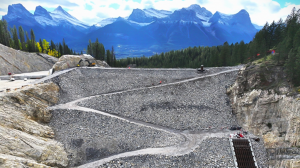June 2017 marks the 20th anniversary of the completion of the Confederation Bridge.
Owned by the Government of Canada, the bridge was built over Northumberland Strait to connect Prince Edward Island and New Brunswick on the mainland.
The Confederation Bridge was built, financed and operated as a P3 (public-private partnership) by private sector developer Strait Crossing Development Inc. (SCDI)
The bridge, which was opened for traffic May 31, 1997, is the longest in the world over ice-covered waters (eight miles/12.9 kilmometres). The anniversary was celebrated June 16 to 18, 2017 in the present-day Canadian fashion: BridgeFest 150, a weekend-long series of such family-friendly events as fireworks, a concert, guided tours of the bridge and a benefit fun-run for the only children’s hospital in Atlantic Canada.
In addition to being feted by kids and their families, the Confederation Bridge deserves to be honoured by industry as the successful result of a unique Canadian engineering and construction project.
"It’s been 20 years, and the bridge is working like a charm," said Michel Le Chasseur, general manager of Strait Crossing Bridge Ltd., which operates the Confederation Bridge. "It should have no trouble reaching its expected design life of 100 years."
John Gamble, president and CEO of the Association of Consulting Engineering Companies — Canada, calls the Confederation Bridge a good example of the contribution by the engineering profession to the quality of life in Canada.
"We’re very proud of it," Gamble said. "The engineering was very complex. It’s not an easy place to build a bridge, thanks to tough geotechnical conditions and the presence of winter ice."
DESIGN
Because the Confederation Bridge is still young, there is more detail in the public record about its design and construction than older Canadian mega projects.
Designed by a consortium headed by a joint venture of J. Muller International and Stantec Consulting Ltd., the structure has three parts: the 14-pier, 1.3 kilometre West Approach Bridge, extending eastward from Jourimain Island, N.B.; the seven-pier, 0.6 kilometre East Approach Bridge, extending westward from Borden-Carleton, P.E.I.; and the 44-pier, 11 kilometre Main Bridge, which joins the approach bridges.
Most of the bridge is 40 metres above sea level. At its highest point, the bridge is 60 metres above sea level, allowing large sea vessels to sail under the bridge between its piers.
The bridge design has several safety features:
Roadway curves ensure drivers remain attentive and reduce the potential for accidents;
The road surface is made of a long-lasting bituminous mixture that minimizes vehicle spray during wet weather;
Concrete barriers minimize visual distraction and serve as a windbreak; and
More than 7,000 drain ports enable rainwater and melting snow and ice to run off.
Designers of the $1-billion bridge developed some innovative solutions to the unusual challenges the project posed. The bridge comprises 175 major structural pieces, including the pier bases and shafts that sit on the ocean floor to support the bridge, as well as the main girders that are the backbone of the structure, that workers had to build and connect.
Special ice shields were designed and installed to protect the support piers from the pack ice that flows through Northumberland Strait every winter.
"The main challenge facing the design team was to demonstrate that the design could meet the requirement that it last 100 years, or twice the average bridge life span," said Eric Tromposch, vice-president and special discipline lead — bridge design in the Calgary office of Stantec Consulting Ltd., and one of the design engineers on the project.
"Our concept was to prefabricate the components on land using high-strength concrete and put them in place with a crane."
CONSTRUCTION
Because SCDI had promised the government that more than 90 per cent of the construction work would go to Atlantic Canadians, it bought a 165-acre farm in Borden, P.E.I., where it built a fabrication yard to construct the giant concrete girders and piers that would be the centre pieces of the bridge.
Construction, most of which was carried out at the on-shore staging facilities, began in October 1993.
After the pre-cast components of the Approach Bridge had been built in New Brunswick, they were transported by truck and barge to either end of the bridge site, where they were assembled in place by a twin launching truss.
For the larger components that were assembled to create the Main Bridge – some weighed more than 7,500 tonnes — crews in P.E.I. used a special purpose-built transporter.
The vehicle moved the components around the fabrication yard, and then out to a jetty where a crane ship picked them up and moved them into position in the Strait.
Global positioning systems, which were still new at the time, enabled engineers to place the components on the ocean floor within an accuracy of two centimetres. At peak production, 2,079 craft workers and 415 staff were employed in building the bridge. In total, more than 5,000 people were employed during the construction phase of the project.
A wholly-owned subsidiary of SCDI, Strait Crossing Bridge Limited, is responsible for managing, maintaining, and operating the bridge until 2032, after which time those responsibilities will be transferred to the Government of Canada.
HISTORY
Like many other Canadian mega-projects, the historical/political back story to the Confederation Bridge reveals just what is in the glue that binds the diverse regions of the country together. The factors leading to the decision to build a fixed-link bridge date back to 1873 and P.E.I.’s decision to join Confederation.
Because it was essential to have a link to the mainland, the island’s political leaders insisted the federal government establish and maintain a ferry service to carry mail and passengers year-round and that Ottawa’s commitment be enshrined in the terms of Confederation.
Over the years, ferry service improved with the construction of ships that could better handle the tough winter conditions in the Strait, but talk of a fixed-link crossing never disappeared. By the late 1980s, with the federal government facing increasing costs of subsidizing ferry service to the Island, Ottawa called for expressions of interest from private companies to build a bridge to the mainland.
Twelve groups submitted proposals and the federal government said it would back the project as long as P.E.I. supported it.
Despite the decades of complaints about the ferry service, the idea of building a fixed-link stirred controversy in P.E.I.. The debate divided the province, one side argued the bridge would bring too many people to the island, endangering its distinct way of life. Its opponents said a bridge would increase tourism and provide a reliable and more cost-effective way to deliver products to the mainland.
The P.E.I. government did not take a public position and called for a plebiscite to decide the issue. In 1988 three out of five Islanders voted in favour of building a bridge to the mainland. The P.E.I. government approved the project with certain conditions.
It demanded from the federal government compensation and re-training for the more than 650 ferry workers who would lose their jobs, compensation for fishermen and -women whose fishing grounds would be disrupted by construction and a promise of substantial economic benefits to the island.









Recent Comments
comments for this post are closed